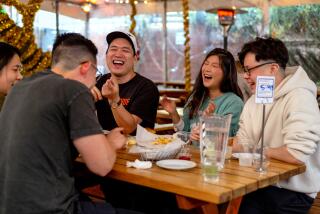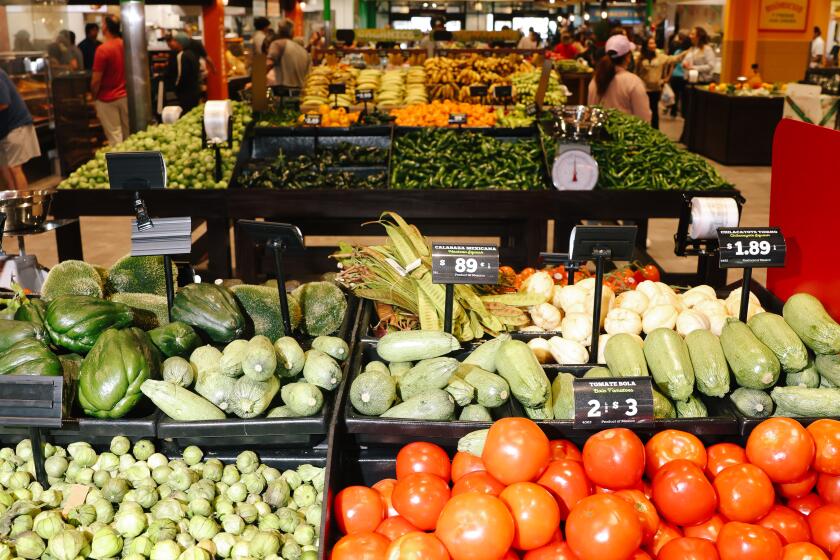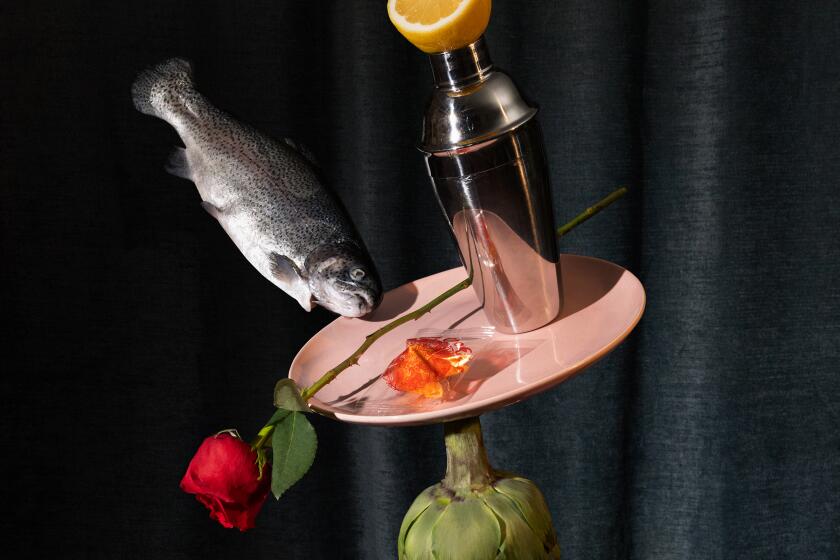Eat What You Are
If you want good luck and more energy this year, change your tastes, hold your tongue and have a baby. Avoid spicy dishes and go for creamy foods and soft, long-cooked dishes.
The reason: the forthcoming Year of the Ox, which begins Friday.
By Chinese astrological reckoning, the ox will dominate the heavens and direct mortals’ fate until Jan. 27, 1998, when the Year of the Tiger arrives. The year that is ending is the Year of the Rat.
Venice astrologer Angel Thompson and father-daughter feng shui consultants Jenny Liu and Chi Jen Liu of Arcadia say a bovine calm will prevail in the Year of the Ox. Thompson and the Lius also predict that anyone who puts a shoulder to the yoke this year will prosper.
“Animals work together in a two-year cycle,” explains Thompson, author of “Feng Shui” (St. Martin’s Griffin, 1996). “The rat represents yang. [It’s] more aggressive, opinionated; a predator who lives off peoples’ crumbs.”
The ox symbolizes yin, the female influence. Thompson says we’re moving from an in-your-face energy to a strong, quiet power. The ox prefers the traditional. It will be a year of roots and families.
What keeps a balance in the universal order of things, including diet, many people of Chinese heritage believe, is an energy force called qi (pronounced chee). In feng shui theory--which is much more than simply rearranging furniture--qi is organized into five elements: metal, fire, water, wood and earth. Individuals are also combinations of these elements.
To encourage good fortune and harmony, according to this theory, individuals can adjust their diets to compensate for any element they might be missing.
So what does the Year of the Ox hold for local food personalities? A few volunteered their vital statistics, including the day and time of their births, and turned them over to Thompson and the Lius, who came up with some predictions. Our advice to the chefs and cookbook authors mentioned: Take these recommendations with, well, a grain of salt.
Chef Nancy Silverton of La Brea Bakery and Campanile and restaurateur Piero Selvaggio, owner of Valentino restaurant, lack earth foods, claim the Lius. To get back into balance, the Lius say, both should add yellow-colored vegetables, peanuts and orange peel to their diets.
Silverton’s husband, chef Mark Peel, lacks metal, in the Lius’ opinion. So do cookbook writer Martha Rose Shulman and restaurateur Joachim Splichal of Patina. Eating soybeans, turkey, chrysanthemum (in tea or petals in a salad), white beans, nappa cabbage and Cornish hen with ginseng over the year can remedy the imbalance, according to feng shui doctrine.
The Year of the Ox is held to be a good year for babies. Thompson wonders if Silverton and Peel will add a fourth to their brood. Silverton responded that she and Peel have no plans for family additions. “If the stork comes to our place,” she assures, “I’ll send it over to my friend Wendy’s house.”
Peel and Silverton are “wood horses,” meaning that they were born in the Year of the Horse in the Wood cycle (with every Year of the Rat, a new cycle of 12 years begins; each cycle is named for one of the elements, the current cycle being water). “Being wood horses, they tend to graze for meals and mull over decisions, or ‘chew their cud.’ ” For what it’s worth, she advises them to stop grazing, to make time to sit for meals and not to skip breakfast.
Splichal, Thompson says, needs to concentrate on being the horse that pulls the cart, rather than a race horse. Concentrate on the details and be finicky about eating, she said.
He should stay away from gourmet foods, the kind he serves, and stick to the bland, continues Thompson. That way he can focus his energies on being creative.
If author Shulman is negotiating a new book contract, says Thomspon, she needs to play it cool. The writer, born in the Year of the Water Tiger, may have trouble with her publisher.
Says Shulman, “I just signed two contracts and things for the most part went OK.”
Still, Thompson advises her to keep opinions quiet and be flexible. A loose cannon could derail something good, adds Thompson. And watch the diet. Go easy on the heavy carbohydrates and meat, fill up on fruits and vegetables.
Martin Yan, Chinese cooking teacher and chef, was born in the Year of the Rat. This year, Thompson says, he’ll prosper and introduce new dishes with vegetables and tofu. His nonstop schedule will continue and, for the next two years, the pressure will be immense. But he can handle it. Says Thompson, “He enjoys what he does. It creates a positive energy, and his bank account will reflect it.”
Selvaggio, a “fire dog,” needs more watery fruits--like melons and grapes--and cabbage, especially in the calmer period of the Year of the Ox, according to Thompson. She says he should also watch for a salt imbalance. “He needs to be careful not to overextend himself in business deals,” says Thompson.
Mary Sue Milliken and Susan Feniger, owners and chefs at the Border Grill and hosts of TV Food Network’s “Two Hot Tamales,” are a strong pair of opposites. “Mary Sue is an ‘earth dog,’ ” says Thompson. “Last year was golden for her. This year, she may not be appreciated. She needs to maintain calm and humility and allow this year to call the shots, and leave big decisions to Susan. Foodwise, she needs to cut back on animal products.”
Feniger, a “water snake,” will be under lots of pressure, but she will succeed. What may cause problems are a sensitive stomach and digestion. Reducing or eliminating dairy products would help, says Thompson. Hmmm. Sounds like difficult advice for a Hot Tamale to follow.
VEGETARIAN STEW
1/2 cup diced onion
3 tablespoons vegetable oil
3 tablespoons soy sauce
Pepper
1 teaspoon salt
2 tablespoons sugar
1 1/2 cups dried black shiitake mushrooms, soaked until softened and stems removed
1 cup dried black fungus, soaked until soft, cut into bite-size pieces
2 cups chopped carrot
16 pieces dried red dates, seeds removed
1/2 cup canned ginkgo nuts
1 cup bamboo shoots or canned baby corn, cut into 1-inch pieces
1 cup canned water chestnuts
3 cups sliced nappa cabbage
1/2 pound vermicelli
Sesame oil
Black bean paste, optional
In Mandarin Chinese, “cai” (pronounced “tsai”) means “vegetable once cooked.” In this traditional New Year’s dish from Marian Liu, mother of feng shui consultant Jenny Liu and wife of feng shui master Chi Jen Liu, the vegetables are regarded as earthy or lucky, and the dates and seeds symbolize fertility. The numbers eight and 10 are both considered lucky, so this stew is made with 8 to 10 types of vegetables. To bring the total to 10, the cook could add celery and another variety of cabbage or even a variety of spinach.
Saute onion in vegetable oil over high heat until onion begins to wilt, about 45 seconds.
Stir in soy sauce, 1/2 teaspoon pepper, salt and sugar. Add mushrooms, black fungus and carrot and cook over low heat. Stir in enough water to cover vegetables. Cook until carrots are tender, about 10 minutes.
Add dates, ginkgo nuts, bamboo shoots, water chestnuts and enough water to cover. Cook over low heat until half of liquid is absorbed, about 20 minutes.
Add cabbage and vermicelli. Stir well and season to taste with pepper, sesame oil and black bean paste. Cook over low heat about 5 minutes longer, or until cabbage and vermicelli are cooked. Add more water if necessary.
8 servings. Each serving:
328 calories; 691 mg sodium; 0 cholesterol; 7 grams fat; 63 grams carbohydrates; 7 grams protein; 3.83 grams fiber.
FRIED RICE: 20 minutes or less
1/2 pound shrimp
Rice wine
1 egg white
1 tablespoon cornstarch
6 tablespoons oil
3 eggs, beaten
2 tablespoons minced garlic
1 cup diced onion
2 carrots, peeled and diced
1 cup frozen green peas, thawed
1 cup frozen corn, thawed
6 cups cooked rice, preferably cooled overnight
1/2 cup diced chives
Salt, pepper
Soy sauce
Making fried rice requires a high flame, a hot wok and many deft hand movements. A staple in Chinese cuisine, fried rice, eaten as a snack or meal, is regarded as an energy food. This recipe comes from Marian Liu.
Shell and devein shrimp.
Mix together 2 tablespoons rice wine, egg white and cornstarch and add shrimp. Let soak 10 minutes.
Heat 2 tablespoons oil in wok over high heat. Rotate wok so that oil covers cooking surface. Once oil begins to glisten or smoke, add eggs. Scramble. Remove from wok and set aside.
Heat 2 tablespoons oil. Add shrimp and stir-fry until flesh turns pink, 1 to 2 minutes. Remove and set aside.
Heat remaining 2 tablespoons oil and add garlic and onion. Stir-fry over high heat until fragrant, about 45 seconds.
Add carrots and stir fry until crisp-tender, about 5 minutes. Add green peas and corn. Stir-fry until thoroughly heated. Reduce heat to medium and add rice, scrambled eggs, shrimp and chives. Stir until thoroughly heated. Season to taste with salt, pepper, soy sauce and rice wine.
8 servings. Each serving:
332 calories; 107 mg sodium; 123 mg cholesterol; 13 grams fat; 40 grams carbohydrates; 17 grams protein; 1.10 grams fiber.
More to Read
Eat your way across L.A.
Get our weekly Tasting Notes newsletter for reviews, news and more.
You may occasionally receive promotional content from the Los Angeles Times.






